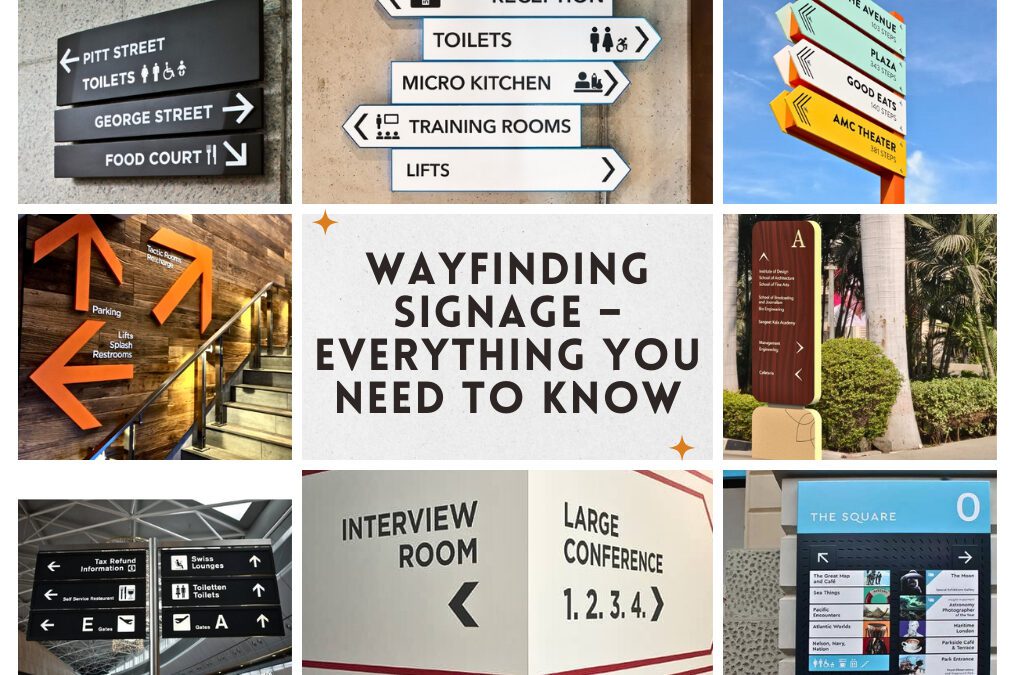Navigating a new environment can be overwhelming. Whether it’s a sprawling shopping mall, a corporate campus, or a busy airport, wayfinding signs play a crucial role in helping people get from point A to point B with ease. In this guide, we’ll explore the basics of wayfinding signage, its importance, and how businesses can use it effectively.
What Is Wayfinding Signage?
Wayfinding signage refers to a system of visual cues—such as signs, maps, symbols, and colors—designed to guide people through physical spaces. The goal is to provide clear and intuitive directions so individuals can reach their destinations without confusion.
The Four Types of Wayfinding Signs
Wayfinding signage typically falls into four main categories:
- Identification Signs
- These signs label specific locations, such as restrooms, conference rooms, or building entrances.
- Example: A sign reading “Main Lobby” or “Café.”
- Directional Signs
- These provide guidance to a destination, often with arrows or landmarks.
- Example: Arrows pointing to “Elevators” or “Parking Lot C.”
- Informational Signs
- These offer general information about a space or event.
- Example: A directory or a floor plan showing all areas within a building.
- Regulatory Signs
- These communicate rules and ensure safety in the environment.
- Example: Signs like “No Smoking” or “Emergency Exit.”
Why Wayfinding Signs Matter?
Effective wayfinding signs:
- Enhance Visitor Experience: Clear signage reduces frustration and ensures smooth navigation.
- Boost Accessibility: Inclusive designs accommodate everyone, including individuals with disabilities.
- Reinforce Branding: Customized signs can integrate a business’s logo, colors, and tone for a cohesive experience.
- Improve Safety: Emergency exits, hazard warnings, and clear directions ensure safety in critical situations.
Key Elements of Effective Wayfinding Signage
To maximize impact, wayfinding signs should adhere to the following principles:
- Clarity
- Use concise, straightforward language.
- Avoid cluttered designs that overwhelm the reader.
- Consistency
- Maintain uniform fonts, colors, and styles across all signs.
- Use universally recognized symbols for ease of understanding.
- Visibility
- Ensure signs are placed at eye level and illuminated in low-light areas.
- Opt for high-contrast colors (e.g., black text on a white background).
- Inclusivity
- Incorporate Braille and tactile elements for visually impaired individuals.
- Use multiple languages if serving a diverse audience.
Applications of Wayfinding Signage
Wayfinding signs are vital in various settings:
- Healthcare Facilities: To help patients and visitors navigate hospitals and clinics.
- Educational Campuses: To guide students, faculty, and visitors to classrooms, auditoriums, and offices.
- Retail Spaces: To direct shoppers to specific stores, restrooms, or parking areas.
- Transportation Hubs: To ensure seamless navigation through airports, train stations, and bus terminals.
Designing Wayfinding Signs with SignageNY
At SignageNY, we specialize in creating custom wayfinding solutions tailored to your business needs. From sleek modern designs for corporate offices to vibrant directional signs for retail spaces, we combine functionality with aesthetics to deliver signage that stands out.
Final Thoughts
Wayfinding signage is more than just directional tools—they shape experiences, boost brand identity, and ensure safety. Investing in well-designed wayfinding signs enhances your space’s functionality and leaves a lasting impression on visitors.
Ready to improve navigation in your space? Contact SignageNY today to discuss your wayfinding signage needs!


Recent Comments